Radicchio di Chioggia PGI a story that begins in 1700
Tradition, Land and a tireless work of man
The history of ‘Radicchio di Chioggia Pgi’ starts from afar and is part of an even more ancient horticultural tradition which has certain documents starting from 1700, when in the city there were several “fraglie” (guilds of craftsmen) and dedicated institutions, including the “Scuola di San Giovanni di Ortolani” which with its 544 students was only second to that of fishermen.
Nonetheless/But already Pliny the Elder told of luxuriant gardens that framed the chioggiotte coasts, as well as of a local therapeutic chicory for food use. However the modern radicchio, as we know it today, derives from individuals with red leaves, attributable to the “Rosso di Treviso” introduced in Europe around the fifteenth century, whose cultivation began to interest the typical areas of the Veneto region during the following century.
Even the Chioggia Pgi, therefore, derives from this common “progenitor”, and the first experiences of Chioggia gardeners were carried out, in the decades following the Great
War, on the “Radicchio Variegato di Castelfranco”.
The endemic poverty of the time led to carrying out various researches of the Italian food production areas, for reviving the horticultural economy and solving the problem of hunger, and one of these studies, of the Federal Credit Institute for the Risorgimento delle Venezie (Pitotti-Belli, Premiate Officine Grafiche Ferrari 1923), dated March 1923, finds that the Radicchio had been included in Chioggia in the agricultural rotation together with other vegetables.
Further confirmation is given in Pagani-Gallimberti’s “Hints of horticultural economy” (Officine Grafiche Ferrari 1929) where is indicated the cultivation technique of Radicchio obtained in the lagoon gardens, gained from the sands conquered by the sea. While the study of 1935 is even more precise on the subject, the “Experimental Gardens of Chioggia” (by the Provincial Council of Corporate Economy Venice, report of 1935), in which studies on new varieties of vegetables and chicory are pointed out with particular reference to Radicchio. At that date, therefore, there was already an evolution of the cultivated varieties, and it is easy to imagine that it was an adaptation to the particular lagoon environment. The gardeners from Chioggia, indeed, by selecting as “seed holders” only the plants with a propensity to become strictly “imbricate” with closed central leaves, avoiding the intrusion of sand raised by sea winds into the hearts of the ‘vegetable heads’, obtained the “Radicchio Variegato di Chioggia”. Later on, around 1950, selecting the plants with increasingly widespread and extensive red streaks, the “Radicchio Rosso di Chioggia” was differentiated.
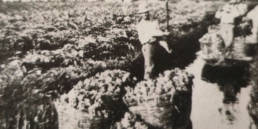
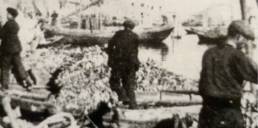
Features
Radicchio di Chioggia is a belonging leafy vegetable to the Asteraceae family (Composite), genus Cichorium, inthybus species, wild variety.
It has a rounded and compact head, with leaves of a more or less intense red color with central and secondary white veins, a bitter taste and a crunchy consistency.
The constant activity of genetic improvement has allowed the selection and spread of two types, which, characterized by a different period of ripening, allow to cover the market for the whole year.
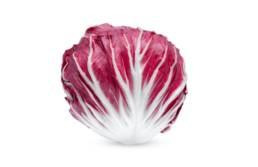
“Early” Chioggia Radicchio
- Appearance
Well closed heart weighing from 200 to 600 grams with the root cut into neat way below the level of the collar.
- Leaves
Characterized by a main white vein that branches off into many small pinnacles and in the leaf limb that is considerably developed with a characteristic color ranging from crimson to amaranth.
- Flavor
Sweet or slightly bitter and with a crunchy consistency.
- Sowing, harvesting and marketing
From 1st December through the end of April in a seedbed, from the beginning of March directly in the field. Harvesting takes place from the 10th of April to July 15th, marketing from 1rst of April to August 31rst.
- Production area
Produced exclusively in the coastal municipalities of Chioggia and Rosolina, thanks to the particularly sandy soil and to the proximity to the sea which determines a higher temperature than inland.
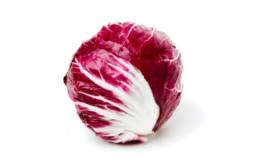
"Late” Radicchio from Chioggia
- Appearance
Well closed heart weighing from 200 to 600 grams with the root cut into a neat way below the level of the collar.
- Leaves
Characterized by a pearl white main vein that branches out into many small penninervie (capillaries) in the remarkably developed leaf limb of deep amaranth color.
- Flavor
Bitter and medium-crunchy consistency.
- Sowing, harvesting and marketing
In the seedbed or directly in the field from 20th of June to August 15th. Harvest from the 1rst of September to March 15th, marketing from September the 1rst to March 31rst.
- Production area
It is produced in all ten municipalities of the Pgi area: Chioggia, Cavarzere, Cona, Codevigo, Correzzola, Rosolina, Loreo, Porto Viro, Taglio di Po and Ariano Polesine.
The seed
A characteristic aspect linked to the production of ‘Radicchio di Chioggia Pgi’ is the selection of the seed. An activity that is still carried out manually by producers, as it represents the true “meaning” of tradition, peculiarity and originality of this magnificent vegetable. The producers select the plants with the best morphological characteristics in cultivation, eradicate them from the field and deprive them of the green external foliar system to keep them in special containers, in a protected environment.
In the following spring, when the climatic conditions allow it, the taproots are transplanted in the open field, under insulators to avoid unespected cross combinations. After about 60 days from the beginning of the flowering, the seed is formed, then the plants are cut off at the root and then left to dry for a few days in the sun for an easier extraction of the seeds that will give life to the new production.
The healthy food that tastes good
The “Radicchio di Chioggia Pgi” is a vegetable that stands out for its high content of antioxidants linked to the typical red color of the leaves and the characteristic slightly bitter taste. There are also compounds that improve the potential health of radicchio represented by chlorogenic acid with antibacterial, antioxidant and chicoric acid which has anti-tumor and antiviral functions, reduces the onset of obesity and diabetes.
Also very interesting is the content of bitter compounds that have anti-inflammatory, protective and choleretic vessels with purifying and hepatoprotective effects. The early Radicchio di Chioggia Pgi, compared to the values found in the national databases, has a good mineral content, a greater presence of potassium (+ 8%), vitamin C (+ 46%), a higher sugar content and fiber values less than 50%.
See the main nutritional characteristics of ‘Radicchio di Chioggia Pgi’ in the tables prepared by Dafnae, department of the University of Padova


Production area
There are 10 municipalities that fall under the PGI area: Chioggia, Cavarzere, Rosolina, Loreo, Porto Viro, Taglio di Po, Ariano, Codevigo, Cona, Correzzola
The production area embraces 10 municipalities which fall into three different provinces: Padua, Venice and Rovigo linked by the same landscape: the one of the adriatic eaves, from the South Lagoon of Venice to the large area of the Po Delta. A unique, beautiful land for large stretches still wild, where man, patiently, has entered into his work without destroying the balance. And it is precisely here that uniqueness and irreproducibility reside of the Radicchio di Chioggia Pgi. The characteristics that make it inimitable certainly derive from the evolutionary history of the product but above all from the pedoclimatic aspects and minerals of the territory. The gardens in which the Chioggia radicchio is grown they originate from the sandstone rocks that the great rivers such as the Po, the Adige and the Brenta have brought from the Alps to the Adriatic.
Therefore, these are soils with a strong presence of minerals to which is added the salinity brought by the sea breezes. ‘Radicchio di Chioggia Pgi’ is in fact the most savory among the italian ‘radicchios’ and among those requiring the least number of interventions with chemical products, since is always the Nature taking care of our vegetable, being the sea winds avoid the stagnation of moisture and the possibility of disease. Average annual rainfall is in place around 700 mm with maximum peaks of 1000mm and minimum of 430 mm. The climate is strongly influenced by the proximity to the sea, which allows a reduced daily thermal excursion, and rarely, during the year, the maximum temperature exceeds 31-32° and the minimum drops below 0 degrees.
A nature-friendly production
In 2014-15 World Biodiversity Association conducted a series of surveys in the production area of the ‘Radicchio di Chioggia Pgi’, through the project “Qualitative characterization of the main Veneto fruit and vegetable products and their production environment” supported by the Veneto region. The aim of the research was to establish, through a census of the organisms living in the three environments (air, water and land) what could be the impact of the cultivation of ‘Radicchio di Chioggia Pgi’ on the ecosystem quality and biodiversity of its production area. The study could highlight that the good agronomic practices carried out by producers, combined with the persistence of some healthy habits such as the ‘wide mass’ selection of the product, it shows that the effects reproduce the natural system of adaptation of plants to an environment, guaranteeing the maintenance of a high biodiversity in the production environment as well as conservation of the soil fertility.

Working process
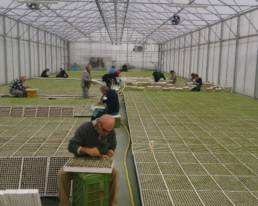
01 The Transplant
It is now common practice to use grown up seedlings for transplanting (normally 30 days pass from sowing to transplanting) in equipped nurseries where producers bring the self-produced seed. Mechanical transplanters are used, but still today, manual transplantation is widely preferred on sandy soils. The distance between the rows varies
from 30 cm for the ‘early’ variety, to 35-40 cm for the ‘late’ variety, while the cultivation practices remain substantially identical.
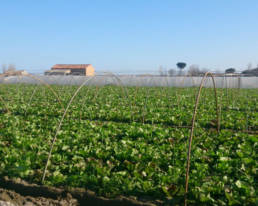
02 Treatments
The interventions are performed when necessary and in any case much less than in the past. Action is mainly taken to fight the red spider and the thrips (especially on sowing), the borer and the noctua (the caterpillar). The sea winds contribute to the low use of pesticides which, mixing the air, prevent the stagnation of humidity and the attack of parasites.
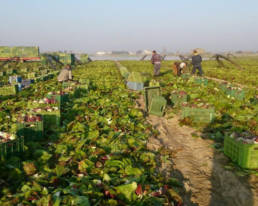
03 The harvest
For both types, the harvesting operation is carried out by cutting the root underneath the insertion of the basal leaves of the heart, usually 2-3 centimeters just below the surface of the soil, when the leaves have imbricated to form a more or less compact heart depending on the type. After cutting the head the outermost leaves are removed, ie those of a non-uniform green or red color.
This first grooming can be done both in the field and in the business center and is aimed at obtaining a “suitable” product to be packaged as Radicchio di Chioggia PGI.
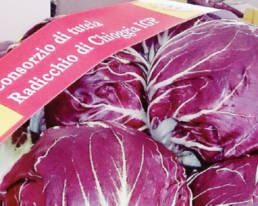
04 Marketing
The marketing period of the Radicchio di Chioggia I.G.P. is from the 1° of April to August the 31°, for the “early” type, and from the 1° of September to March the 31° for the “late” one. To be released for consumption, the radicchio bearing the name “Radicchio di Chioggia PGI” must be packaged in containers with characteristics that allow the product to be preserved in good condition. In the case of intended product the processing industry can be marketed in bins, while for the final consumer a sealing cover must be affixed to prevent the contents from being tampered with; alternatively, each package must still be equipped with a weight traceability system by affixing the lot number.
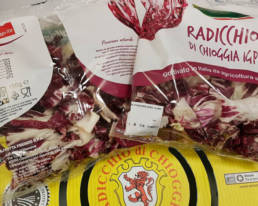
05 Fourth range
After the grooming operations carried out in the field, the Radicchio di Chioggia I.G.P. (it) can be subjected to Fourth Range processes. These packaging operations can be carried out also in processing centers located outside the production area defined by the specification. However on the containers must be visible the logo indicating, in print characters of the same size, the words “Radicchio di Chioggia I.G.P.”, with specific reference to the packaged of the”Early” type or the “Late” one.
Even on the packaging of fresh-cut products, with the Chioggia Radicchio packaged in bags, cut and washed ready for consumption, the logos of the IGP denomination stand out.
The ‘Radicchio di Chioggia’-based products
The nutraceutical and nutritional characteristics of ‘Radicchio di Chioggia’, combined with its flexibility in the kitchen makes a special ingredient of many enogastronomical preparations and also of many products that are on the market today.
The leaves of the Red Prince are used as a component in the production of pasta, in the creation of cosmetics, in dried form in ready-made bags to flavor desserts and ‘risottos’, but also jams, herbal teas, ice cream and even a red beer!
The Red Prince, king on the table
The unique qualities of the ‘Radicchio di Chioggia Pgi’ are increasingly used for cooking by both: starred chefs and families for their everyday dishes. This type of radicchio can be eaten both raw and cooked ranging from simple salads to risottos or as a main course, if grilled on the grill, while sautéed it is the perfect side dish to accompany meat and fish. Consumed raw it gives the maximum of vitamins, cooked in various ways can satisfy the most demanding palates.

